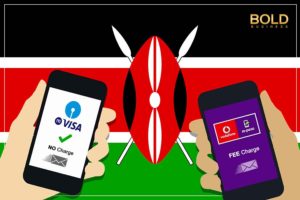Africa isn’t the first place that comes to mind when you think of bold innovations in business; but it is on the leading edge in a particular type of money system, one that is not issued by a federal reserve bank or backed by the petrodollar. While Bitcoin is the darling breakout currency in North America, Africans have their own currency that has been in use and evolving for over a decade. That currency is processed via mobile phone money transfer from MPESA.
Almost $5 billion dollars were transferred person-to-person in Kenya in the last quarter alone.
In terms of business development, one huge challenge was that most Africans are “unbanked.” They don’t have access to a bank in their towns and villages, and often lack reliable electricity, let alone internet.
The coming of the smartphone opened huge possibilities of connectivity for these people. Seemingly in the blink of an eye they gained the ability to connect with the world, but they still lacked credit cards and bank accounts. The African infrastructure simply could not accommodate their needs.
Enter MPESA, which is perched atop the Vodafone cellphone system. This currency is based on cell phone minutes. And they can be traded like money. This is now the default currency in many areas Kenya and nearby regions. It provides a handy and clean way to conduct financial transactions digitally.
Forbes mentioned that the idea first started after a group of researchers financed by the Department for International Development (DFID) in the UK, a foreign aid arm of the British Government, found out that people in Kenya were transferring mobile airtime as a proxy for cash.
Nick Hughes, the Head of Global Payments at Vodafone, fleshed out and developed the idea of MPESA into a working currency. He applied for funding through a challenge fund of DFID. DFID and Vodafone each contributed 1 million Euros.
MPESA Goes Global

Anyone with a smartphone can use MPESA to;
- Deposit cash into an account that is stored on their mobile phones.
- Send balances just by using PIN-secured SMS text messages to other users.
- Redeem deposits for regular cash.
Because of this new and easy approach of transferring money, MPESA spread quickly and gained popularity in many different places where banking services may be challenging to find or expensive. Many countries in Esatern Europe are using the currency, as well as, Mozambique, Lesotho, Egypt, India, South Africa, Afghanistan, and Tanzania.
Being next door to Kenya, Tanzania was one of the first countries to pick up MPESA, in 2008. In the same year, Vodafone worked together with Roshan, a primary mobile operator in Afghanistan, in order to launch MPESA. Nedbank and Vodacom took the service to South Africa in September of 2010. MPESA launched in India back in April 2013 and Romania in March 2014.
MPESA is now facing competition. Almost $5 billion dollars were transferred person-to-person in Kenya in the last quarter alone. That’s a big chunk of change and even with small transaction costs, it adds up to a substantial sum.
Of course competitors have entered the marketplace, most recently mVisa, which also works on mobile phones and offers Kenyans a way to pay for goods and services. mVisa allows for free transfers of funds from individual to individual in some circumstances. mVisa is intent on capturing a share of the African transaction market from MPESA.
mVisa is Coming to Kenya Banks
PayBefore stated nine banks in Kenya will acquire merchants to accept mVisa or allow mVisa on their banking applications starting in July 14 this year.
- Barclays Bank – The bank is a big financial institution in Kenya, having an asset base in excess of KES:200.975 billion or [US$2.329 billion]. It is the fifth biggest commercial bank in Kenya.
- Cooperative Bank – The bank is the biggest commercial bank in the East African Community. In 2010, the London Financial Times awarded Cooperative Bank the “Best Bank of Kenya”.
- Ecobank – The bank is a Pan-African banking conglomerate, officially, Ecobank Transnational Incorporated. Ecobank is the number one independent regional banking group in Central Africa and West Africa.
- Family Bank – The bank is a medium-sized commercial bank in Kenya. The bank had a customer base of over 1.8 million and had 93 branches in Kenya as of June 2016.
- KCB Bank – The bank is a financial services holding company that is located in the region of African Great Lakes. The bank has assets of KES:556.6 billion and a shareholders’ equity of KES:78.1 billion as of December 2015.
- National Bank of Kenya – The bank serves individuals, large corporations, and small-to-medium companies and businesses. Its subsidiaries are Natbank Trustee and Investment Services Limited, Kenya National Capital Corporation Limited, and NBK Insurance Agency Limited.
- NIC Bank – The bank has assets that are valued at over KES:108.35 billion [US$1.26 billion] as of December 2012.
- Prime Bank – The bank is located in Bangladesh and is a private commercial bank.
- Standard Chartered Bank – The bank is sometimes called Stanchart Kenya. It is a commercial bank. Central Bank of Kenya has provided a license to Standard Chartered Bank.
Uttam Nayak, the Senior Vice President of Digital for Emerging Markets of Visa Incorporated, said that “Customers have told us they appreciate how fast and easy it is to use mVisa.”
This statement has boosted the confidence of many people in Kenya. It will not only cater to regular citizens but to businesses and companies as well. It is fascinating how solutions can be presented when really needed. M-PESA and mVisa are just some of the innovations that are helping the developing countries like Kenya.









